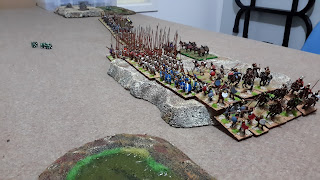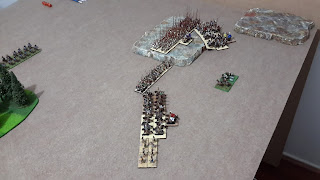Back to the game ....
The Romans deployed first after deciding to commit less scouting dice to the contest. Rome had a clear advantage in medium troops, through their armoured auxilia, but did not make use of the rough terrain. Alexander decided to deploy forward, winning the race to the rough terrain on the flank. He would plough his phalanx straight into the medium Roman foot ... in the open terrain. Alexander's cavalry would hold back .... which was exactly what the legion was doing .... which did not end too well.
The Macedonians stack their right flank, ready to overwhelm then turn onto the centre.
The Romans deployed their auxilia forward ... would they be able to be supported?
The proconsul pushed his cavalry forward on his left ... but this took time to perform and make a line ready for battle.
Meanwhile, the Macedonian attack was in full swing. Archers are competent troops against lights, mediums or cavalry but struggle to make a dent in a line of heavy foot with shieldwall. The Romans threw forward a semi-sacrifical medium foot unit to slow the advance. Would Ares smile upon this offering?
The lone unit battled bravely, but its only support came in the form of flights of arrows. These did not deter the advance.
On the right, Alexander awaited the Roman advance, happy for them to be using dice to move forward quickly that he was using for the left flank combat. Polydamas and Onomastus, my elephants, calmly awaited the cavalry dreaming of carnage.
The Scythians shot away the Roman light cavalry ... the flank was open!
The first pike unit was released ... it annihilated the first archer unit but was halted by the second it pursued into.
The Roman cavalry flinched, charging the elephants. The result was predictable but this sent Polydamas and Onomastus careening forward without support. It also bought them in range of the Roman scorpio's.
The Roman flank was battered but not yet broken. However each auxilia unit faced twice their number of opponents.
The elephants, although peppered with shot, stomped their way over a cohort of raw legion before halting on another legionary unit. The Roman legate, frustrated by their success, turned a unit of cavalry to flank them. Hoplites and Greek allied cavalry from Corinth rushed to support but it was too late for the jumbo's ... but damage had been done.
Better coordination by Alexander and Craterus on the left saw heavy foot unit after unit crash into the Romans. It was now revealed how damaging the rear deployment of the cohorts had been. They now advanced slowly and piecemeal to the fray.
The Greek cavalry held up the armoured Roman lancers (impact cavalry) while the companions trounced the other unit.
Here everything went astray for the Macedonians ... two units were lost. One companion unit fell to a volley of scorpio bolts. A hoplite unit then took four hits in one round of combat (!) and a single cohort pushed through onto the flank of a pike block. Having six hits however allows a pike block to stand up to surprising levels of punishment.
The end of the battle ... Roman units held up for a while but eventually fell to the pike push and the peltasts flanking move. Besides a slight hiccup the forces of Alexander taste victory again. The Romans broke while Alexander had lost but 3 units - 12 army points - still a way to go before 1/3 losses. The Macedonian army certainly feels stronger in 500 pts than 400 but a stronger challenge awaits at he club this Sunday ... battle against a first Crusade force .... a large offering to Tyche and and Zeus will be required.



























































